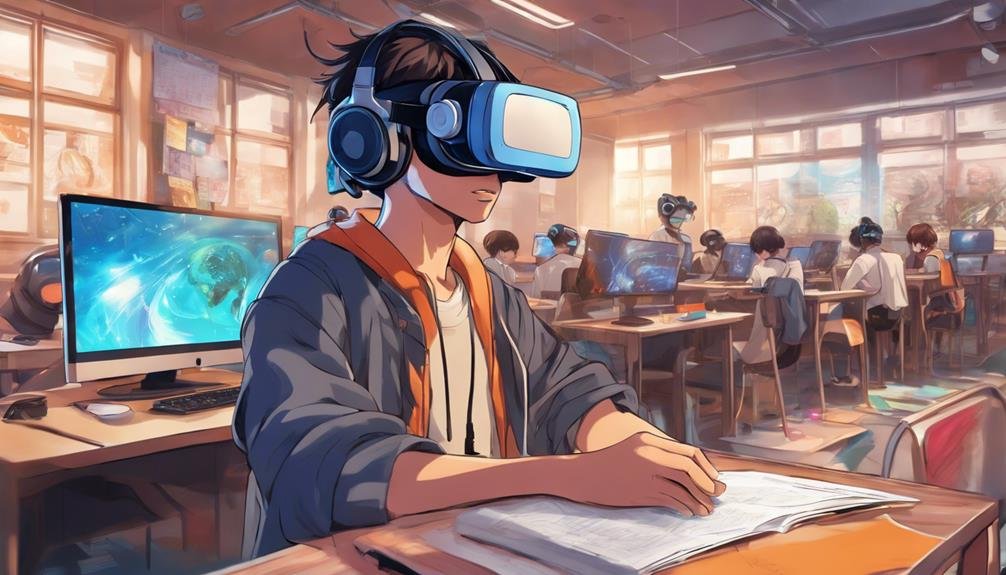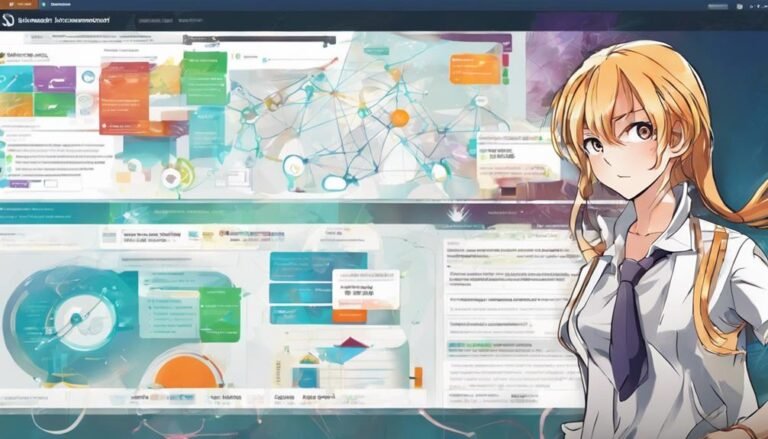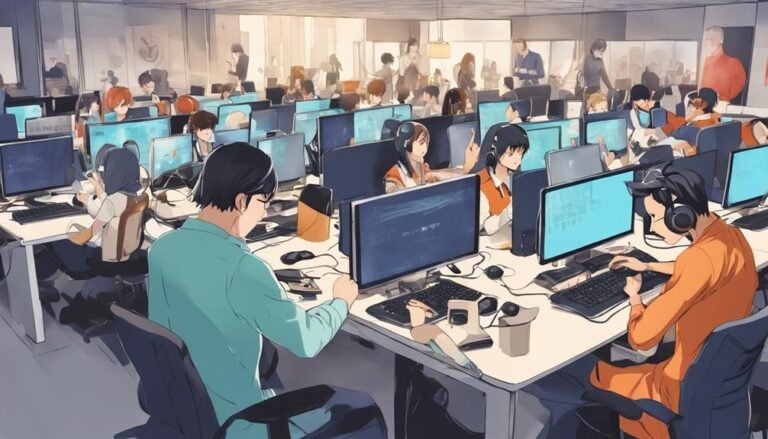What Are the Challenges of Integrating Virtual Reality (Vr) in E-Learning?
Integrating Virtual Reality (VR) in E-Learning poses challenges like limited hardware compatibility, high costs, and technical support needs. Content creation complexities arise from designing immersive environments while ensuring inclusivity and accessibility. Educators face a learning curve in adopting VR tools and integrating them with existing systems. Despite obstacles, VR offers enhanced learning outcomes and immersive experiences. To learn in-depth strategies for overcoming these challenges and optimizing VR integration in E-Learning, explore further insights within the domain of educational technology integration.
Key Takeaways
- Hardware compatibility issues hinder seamless integration.
- High implementation costs pose financial challenges.
- Technical support requirements are crucial for user assistance.
- Content creation complexities demand attention to detail.
- Accessibility and inclusivity issues must be addressed for diverse learners.
Limited Hardware Compatibility
Limited hardware compatibility poses a significant challenge when integrating VR technology in e-learning environments. Hardware limitations and compatibility issues often hinder seamless integration of VR experiences into educational platforms. The diverse range of VR devices available in the market makes it challenging for e-learning developers to create content that can run smoothly across all platforms.
Ensuring that the VR content is compatible with various devices requires additional time and resources. Developers must optimize the content for different hardware specifications, which can lead to fragmented user experiences. Additionally, the cost of acquiring VR-compatible hardware can be prohibitive for educational institutions looking to implement VR technology in e-learning.
To address these challenges, it's essential for e-learning providers to conduct thorough research on the hardware requirements of their target audience and develop VR content that's accessible across a wide range of devices. By prioritizing compatibility and investing in versatile VR solutions, e-learning platforms can overcome the limitations posed by hardware disparities and offer a more inclusive educational experience.
High Implementation Costs
Implementing VR technology in e-learning environments often entails significant financial investments due to high implementation costs. Cost management becomes essential when considering the integration of virtual reality into educational platforms.
The initial setup expenses, including VR headsets, controllers, sensors, and software development, can pose challenges for institutions with budget constraints. Resource allocation for VR implementation requires careful planning to guarantee adequate funding for hardware, software, and content creation.
Scalability challenges arise as institutions need to weigh the long-term costs of maintaining and updating VR technologies to keep pace with advancements in the field. Balancing the budget for VR integration while optimizing the learning experience for students is a delicate task that demands strategic decision-making.
To address high implementation costs effectively, educational institutions must prioritize investments, explore cost-saving strategies, and consider the long-term benefits of incorporating VR into e-learning environments.
Technical Support Requirements
In order to guarantee the successful integration of VR technology in e-learning, addressing the technical support requirements becomes an important component following the challenges of high implementation costs. To ensure a smooth changeover and efficient use of VR in e-learning, consider the following:
- User Training: Providing thorough training to instructors, administrators, and students is essential for the effective utilization of VR technology. Proper training will enhance user competency, leading to improved learning outcomes.
- Software Updates: Regular software updates are vital to maintain system functionality, security, and compatibility with evolving e-learning platforms. Keeping VR software up to date ensures top performance and minimizes technical issues.
- Technical Support Services: Establishing a reliable technical support system is critical for promptly addressing user queries, troubleshooting hardware or software problems, and ensuring uninterrupted access to VR resources. Accessible technical support enhances user experience and fosters confidence in utilizing VR technology for e-learning purposes.
Content Creation Complexities
Traversing through the intricacies of content creation in VR for e-learning can present unique challenges that require careful consideration and strategic planning. The shift from traditional e-learning content to virtual reality involves the development of interactive simulations and immersive environments tailored to engage and educate learners effectively.
Designing interactive simulations demands a deeper understanding of user experience and instructional design principles to guarantee seamless integration of content with the virtual environment. Immersive environments, on the other hand, require meticulous attention to detail in creating realistic settings that enhance the learning experience.
The complexities of content creation in VR for e-learning also extend to the technical aspects of producing high-quality graphics, animations, and audio that contribute to the overall immersion. Balancing the need for visually appealing content with optimized performance can be a significant challenge. Additionally, ensuring that the content remains engaging and educational without overwhelming learners in these immersive environments poses a creative hurdle that content creators must navigate skillfully.
Accessibility and Inclusivity Issues
Exploring the domain of accessibility and inclusivity in VR for e-learning demands a nuanced strategy to ensure equal learning opportunities for all individuals. When considering equity considerations and diverse learners, it's essential to address the following key points:
- Hardware and Software Accessibility: Ensuring that VR technology is compatible with assistive devices and that software interfaces are designed with accessibility features can help cater to diverse learners, including those with disabilities.
- Content Representation: Providing a range of content formats, such as subtitles, audio descriptions, and text-to-speech functionalities, can enhance the learning experience for individuals with different learning preferences and abilities.
- Training and Support: Educators and instructional designers must receive training on creating inclusive VR experiences and be provided with resources to support diverse learners effectively. This proactive approach can help mitigate barriers and promote a more inclusive e-learning environment for all.
Learning Curve for Educators
Exploring the domain of integrating VR in e-learning, educators face the challenge of overcoming the learning curve associated with adopting new technological tools and instructional methods. Educator training becomes pivotal in maneuvering this terrain effectively. As an educator, delving into VR for e-learning necessitates grasping not only the technical aspects of the technology but also understanding how to seamlessly integrate it into educational practices.
Technology adoption plays a significant role in this process. Familiarizing yourself with VR tools and their applications is just the beginning. You must also learn how to tailor educational content to maximize the potential of VR, creating immersive and engaging learning experiences for your students. This shift requires a shift in mindset, moving from traditional teaching methods to innovative, interactive approaches.
To conquer the learning curve, actively seek out professional development opportunities focused on VR in education. By continuously enhancing your skills and knowledge in this area, you can effectively harness the power of VR to revolutionize e-learning and elevate the educational experience for your students.
Integration With Existing LMS
Exploring the integration of Virtual Reality (VR) with your existing Learning Management System (LMS) requires a strategic approach to optimize the synergy between the two technologies. When considering this integration, focus on the following key points:
- User Engagement: Incorporating VR into your LMS can greatly enhance user engagement by creating immersive and interactive learning experiences. This heightened engagement can lead to increased motivation and better knowledge retention among learners.
- Learning Outcomes: By integrating VR with your LMS, you can potentially enhance learning outcomes. VR technology offers a more practical and experiential approach to learning, allowing users to apply theoretical knowledge in simulated real-world scenarios. This hands-on learning experience can improve understanding and skill development.
- Seamless Integration: Ensuring a smooth integration between VR and your existing LMS is essential. This involves compatibility testing, technical support, and user training to guarantee a smooth flow and excellent performance of the integrated systems.
Data Privacy and Security Concerns
When pondering the integration of VR in e-learning, it's essential to address data privacy and security concerns.
You need to guarantee compliance with privacy regulations, safeguard user data, and implement robust cybersecurity measures.
Protecting sensitive information and maintaining a secure virtual learning environment are paramount in utilizing VR effectively for educational purposes.
Privacy Regulations and Compliance
Privacy regulations and compliance regarding data privacy and security concerns are crucial in the integration of VR technology in e-learning. To guarantee a safe and secure environment for users, consider the following:
- Data Encryption: Implement robust encryption protocols to safeguard sensitive information transmitted within the VR e-learning platform.
- Consent Management: Obtain explicit consent from users regarding the collection and processing of their personal data within the VR environment.
- Regulatory Compliance: Adhere to relevant data privacy regulations such as GDPR or CCPA to protect user data and avoid legal repercussions.
User Data Protection
In the domain of e-learning integrated with VR technology, ensuring robust user data protection is essential for maintaining a secure and trustworthy digital learning environment. Data encryption plays an important role in safeguarding sensitive information from unauthorized access. It's imperative to implement strong encryption methods to secure user data transmitted and stored within the VR e-learning platforms.
Additionally, consent management is crucial to respecting users' privacy rights and ensuring that their data is used only for agreed-upon purposes. By incorporating effective consent management practices, e-learning platforms can build trust with users and demonstrate a commitment to data privacy.
Striking a balance between seamless user experience and stringent data protection measures is crucial for the successful integration of VR in e-learning.
Cybersecurity Measures
To fortify the security of user data in VR-integrated e-learning environments, implementing robust cybersecurity measures is essential. When considering cybersecurity in VR e-learning, focus on the following key aspects:
- Network Vulnerabilities: Identifying and addressing potential weaknesses in the network infrastructure is vital to prevent unauthorized access and data breaches.
- Authentication Protocols: Implementing strong authentication mechanisms guarantees that only authorized users can access sensitive information, reducing the risk of data breaches.
- Encryption Standards: Utilizing advanced encryption techniques helps safeguard data transmitted within the VR e-learning system, protecting it from cyber threats and unauthorized access.
User Experience Design Challenges
Exploring the intricate landscape of user experience design in VR for e-learning presents numerous challenges that demand innovative solutions. When it comes to interactive simulations, creating a seamless and intuitive user interface within virtual reality environments can be quite complex. Users expect a high degree of interactivity and responsiveness, requiring designers to carefully balance functionality with user engagement.
Immersive environments add another layer of complexity to user experience design in VR for e-learning. Designers must make sure that the virtual space not only looks realistic but also functions in a way that enhances the learning experience. Issues such as motion sickness, visual fatigue, and cognitive overload need to be addressed through thoughtful design choices.
Furthermore, optimizing user experience design for various VR devices and platforms poses a significant challenge. Ensuring that the e-learning content is accessible and enjoyable across different hardware setups requires careful consideration of factors like input mechanisms, display resolutions, and tracking capabilities. Meeting these challenges head-on will be vital in harnessing the full potential of VR for e-learning.
Conclusion
To sum up, integrating virtual reality in e-learning presents a plethora of challenges such as limited hardware compatibility, high costs, technical support needs, and content creation complexities.
However, despite these obstacles, the potential benefits of VR in enhancing learning experiences can't be ignored.
It's like trying to fit a square peg in a round hole – difficult, but with the right strategies and support, it can revolutionize the way we educate and engage learners in the digital age.







